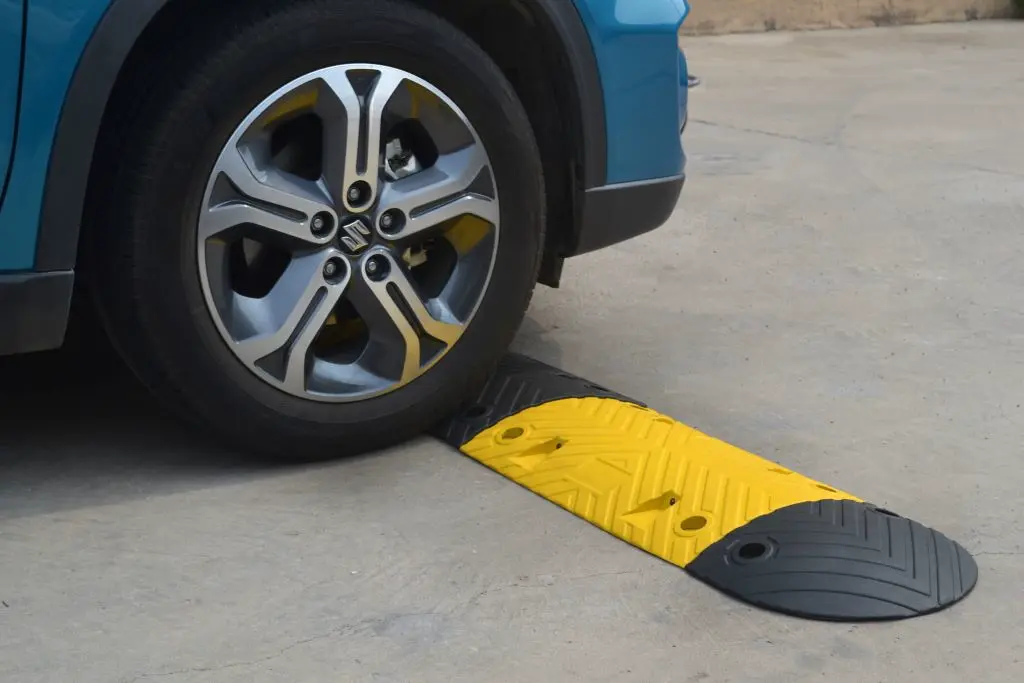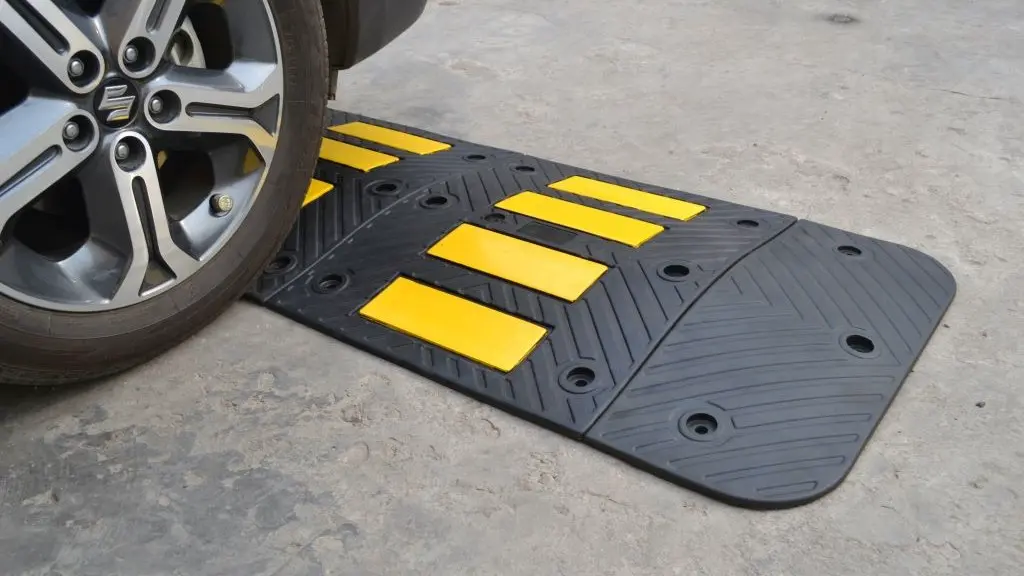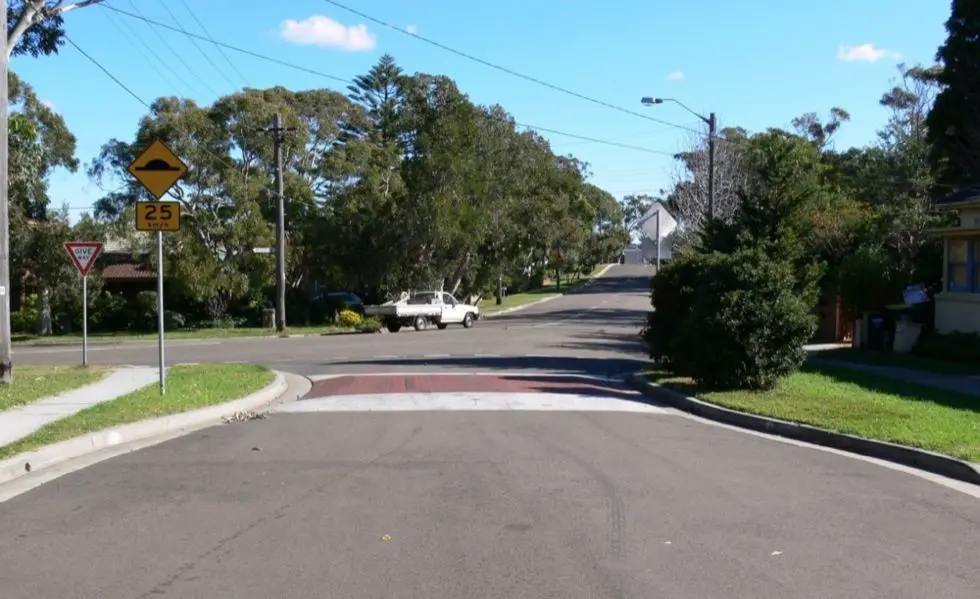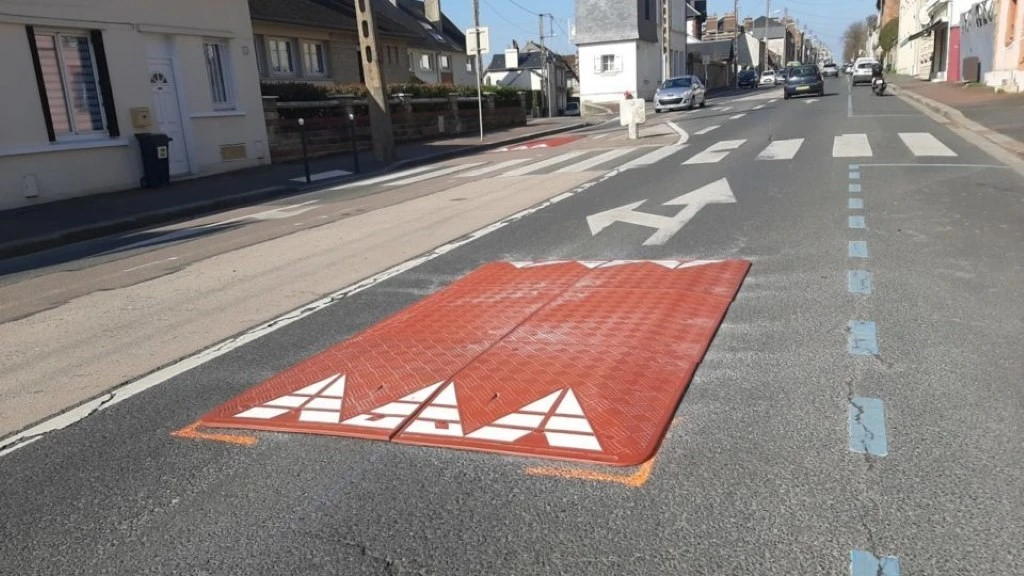Speed Bumps, Humps, Tables, Cushions – What’s the difference?
The rate of road accidents is rising worldwide with time. Many factors, including poor maintenance of roads, lack of traffic calming measures, and bad driving, come into play.
The federal highway administration and the transportation department are responsible for enhancing road safety and pedestrian safety. To fulfill this duty, they use different traffic control devices, such as speed humps, bumps, cushions, rumble strips, and traffic signals.
Each device has a unique design that serves a different purpose than others. In this article, you will learn the key differences between some of the most popular speed-reduction tools.
For more information about Speed Cushions, you can discover here: Speed Cushions: All answers to your questions.

Discover here our full range of Speed Cushions!
Introduction to traffic calming accessories
Traffic calming accessories or devices are used worldwide to increase the safety of pedestrians, drivers, and vehicles. They come in many forms, shapes, designs, and dimensions. You should select the one that best meets your traffic-management needs.
Some examples of these accessories are:
- Speed breakers
- Road bumps
- Rubber wheel stops
- Traffic cones
- Speed signs
- Pavement markings
- Traffic signs
- Traffic barriers
- Bollards
Transportation engineers buy them for multiple reasons. Below are the key reasons for installing traffic calming tools on your city streets, roadways, and parking lots.
- Reduce acceleration of speeding vehicles to prevent road accidents and fatalities.
- Keep vehicles in their lanes to ensure vehicular organization and management.
- Minimize the risk of vehicle-to-vehicle or vehicle-to-pedestrian collisions.
- Ensure emergency vehicles reach their destination fast.
- Provide secure parking spots to drivers.
- Keep all kinds of vehicular drivers, including bicyclists, cyclists, buses, cars, etc., safe.
- Promote responsible driving.
- Make pedestrian crossings safe for foot traffic.

What is a speed bump?
Here is a brief intro to speed bumps.
Speed bump definition
A speed bump is a traffic safety tool with a raised surface spread across the width of a roadway, street parking space, or slow zone. It is used to reduce the speed of vehicles from 5 to 10 miles per hour (mph).
Advantages
Some of the main advantages of speed bumps are:
- You can use it in various places, including roundabouts, traffic lanes, intersections, and per-hour parking areas.
- It can reduce the risk of collision between vehicles.
Disadvantages
Some key cons of using speed bumps are:
- It causes the accumulation of stormwater.
- It produces a noticeable impact on vehicles (when drivers drive over them at high speed) which could cause internal damage to vehicles.
- It causes traffic noise.
Applications
Their most common uses are:
- You can use it in parking lots to increase the safety of foot traffic and vehicles.
- You can install it in school and work zones to protect students and employees.

Get in touch
The Speed Cushions Factory is a leading manufacturer of rubber speed cushions located in Qingdao, China.
Feel free to contact us!
We are always here to help!
Qingdao, Shandong Province, China.
sales@speed-cushion.com
What is a speed hump?
Here is a brief intro to speed humps.
Speed hump definition
Structure-wise, speed bumps and speed humps are similar to each other. It means a speed hump also has a raised surface spread across the width of a road. The only difference is that the length of a speed hump is more than that of a speed bump, while its height is smaller than it.
Speed humps are used in a road, driveway, or intersection where the traffic limit is 10 to 15 mph.
Advantages
Their prominent pros are:
- It is available in different sizes, so buyers can select the one that best meets their traffic control needs.
- It is manufactured with various materials, such as recycled plastic, recycled rubber, wood, metal, concrete, and asphalt.
- It can reduce the speed of all kinds of vehicles.
Disadvantages
These include:
- It reduces the response time of emergency vehicles such as ambulances and fire trucks.
- It may cause internal damage to vehicles that drive over it often.
Applications
These include:
- You can use it in residential streets to offer protection to pedestrians.
- You can install it in parking lots to promote vehicular and pedestrian safety.
- It can be installed in a bicycle or bike lane.

What is a speed table?
Here is a brief intro to speed tables.
Speed table definition
Speed tables are considered the modified version of speed humps, having a long flat-top that can raise the complete wheelbase of a standard vehicle at once. They are preferably used on roads and streets where an 8 to 15-mph speed reduction is required.
Advantages
Its popular pros are:
- It can be used in emergency vehicle routes.
- It does not cause significant damage to vehicles when they drive over it at high speed.
- It produces less traffic noise compared to the tools mentioned above.
Disadvantages
Common disadvantages of speed tables are:
- It may slightly reduce the emergency response time.
- It may cause a tripping hazard if it is installed in a dark place or it does not have reflective tape.
Applications
These include:
- You can use it in pedestrian crossing to protect foot traffic.
- You can use it on roads where motor-vehicle drivers often drive at high speed.
- You can use it in conjunction with curb reductions or extensions.

What is a speed cushion?
Here is a brief intro to speed cushions.
Speed cushion definition
A speed cushion is another traffic calming device used on roads and streets. It is similar to speed tables somehow, but the key difference is that it has wheel cutouts that speed tables lack.
The width of a speed cushion is more than the width of a car and less than that of an emergency vehicle or any other large-sized vehicle. It reduces the speed of vehicles from 15 to 20 mph.
Advantages
These are:
- It does not affect emergency response time.
- It produces less traffic noise and vehicular impact than the abovementioned devices.
- It does not cause water accumulation and helps with its drainage.
- It helps promote responsible and safe driving.
Disadvantages
Such as:
- It does not reduce the speed of cyclists and bicyclists.
Applications
These include:
- You can use it in pairs or a group of three according to the width of a road.
- You can use it on the streets to prevent accidents.

Which traffic calming tool is the best?
All the traffic calming tools have significance and are the best in their way. But if you ask which tool to buy from these options, we suggest you use the tool that best meets your specific needs.
For instance, if you need a speed control tool for street parking or public parking, you should go for speed bumps or humps. However, it is better to choose speed cushions if you need something for a road, street, or emergency vehicle route.
Speed cushion is also a good option for roads where you don’t want rainwater to accumulate. It is also suitable for roadways where bicyclists or cyclists go often.
Conclusion
Speed bumps, humps, tables, and cushions are very effective speed-reduction tools. You can install them in numerous places to make your streets and roads safe for people. They are available in different designs, shapes, and sizes to allow people to choose a tool that best suits their particular traffic control needs.
Speed cushions are one of the must-have traffic control tools for roads and streets. They offer many benefits that are hard to find on other devices. For instance, they do not force large vehicles to reduce their speed, and they do not cause rainwater to accumulate.
You should use this tool if you want to make your emergency vehicle routes and roads safe for foot and vehicular traffic.
Get in touch
The Speed Cushions Factory is a leading manufacturer of rubber speed cushions located in Qingdao, China.
Feel free to contact us!
We are always here to help!
Qingdao, Shandong Province, China.
sales@speed-cushion.com
You might be interested in the below articles:
- What are the Most Famous Traffic Calming Devices?
- How Far apart should Speed Cushions be Installed?
- How to Install a Speed Cushion?
- Top 5 Speed Cushions Brands!
- What are the Dimensions of a Speed Cushion?
- Speed Cushions vs. Speed Bumps, Humps, and Tables
- Speed Cushions in Different American Cities
- How does a Speed Cushion work?
- What are Speed Cushions Regulations?
- Top 8 Frequently Asked Questions about Speed Cushions